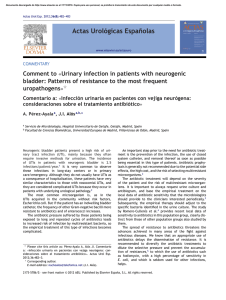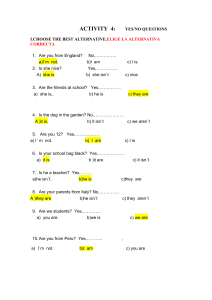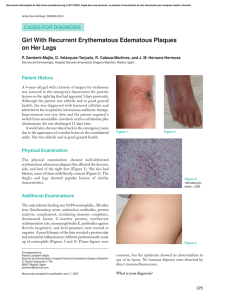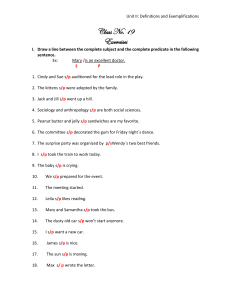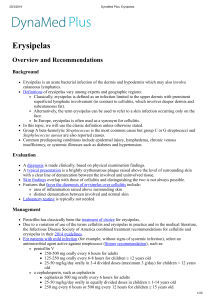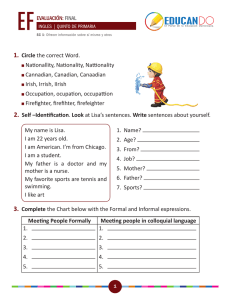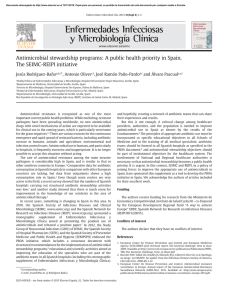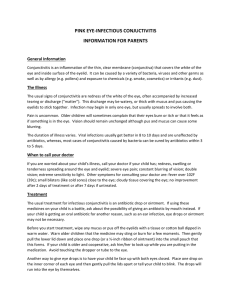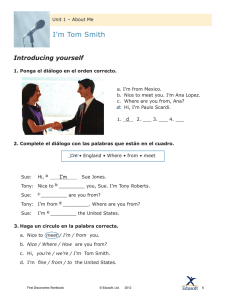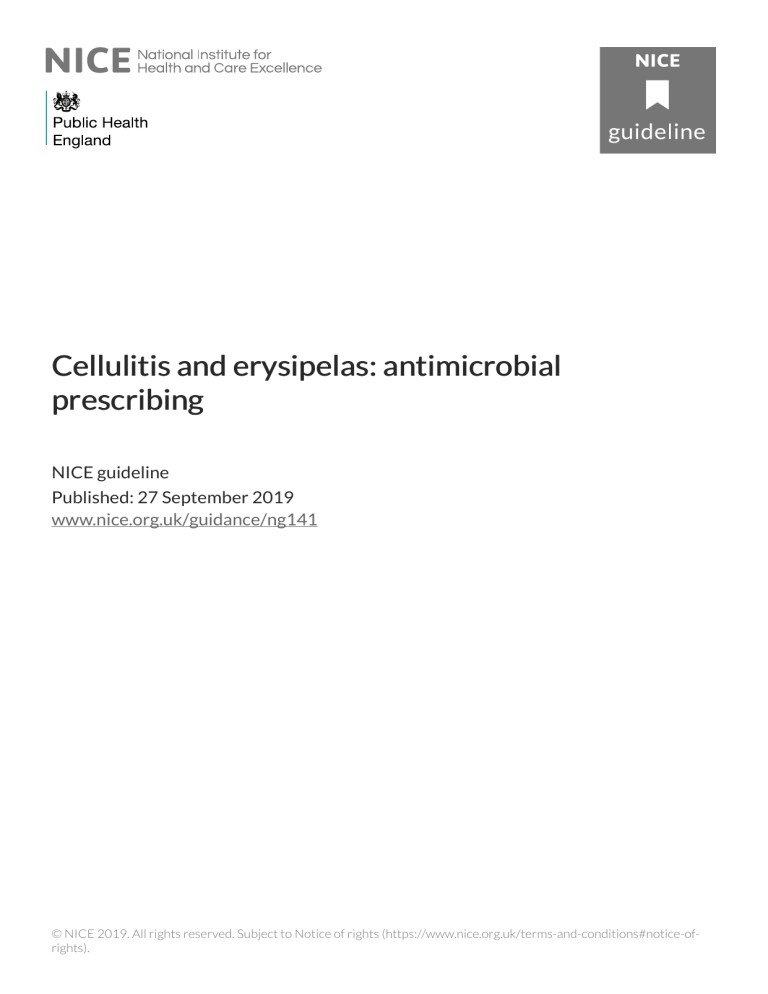
Cellulitis and erysipelas: antimicrobial prescribing NICE guideline Published: 27 September 2019 www.nice.org.uk/guidance/ng141 © NICE 2019. All rights reserved. Subject to Notice of rights (https://www.nice.org.uk/terms-and-conditions#notice-ofrights). Cellulitis and erysipelas: antimicrobial prescribing (NG141) Your responsibility The recommendations in this guideline represent the view of NICE, arrived at after careful consideration of the evidence available. When exercising their judgement, professionals and practitioners are expected to take this guideline fully into account, alongside the individual needs, preferences and values of their patients or the people using their service. It is not mandatory to apply the recommendations, and the guideline does not override the responsibility to make decisions appropriate to the circumstances of the individual, in consultation with them and their families and carers or guardian. Local commissioners and providers of healthcare have a responsibility to enable the guideline to be applied when individual professionals and people using services wish to use it. They should do so in the context of local and national priorities for funding and developing services, and in light of their duties to have due regard to the need to eliminate unlawful discrimination, to advance equality of opportunity and to reduce health inequalities. Nothing in this guideline should be interpreted in a way that would be inconsistent with complying with those duties. Commissioners and providers have a responsibility to promote an environmentally sustainable health and care system and should assess and reduce the environmental impact of implementing NICE recommendations wherever possible. © NICE 2019. All rights reserved. Subject to Notice of rights (https://www.nice.org.uk/terms-andconditions#notice-of-rights). Page 2 of 36 Cellulitis and erysipelas: antimicrobial prescribing (NG141) Contents Overview .............................................................................................................................................................................. 4 Who is it for? ..................................................................................................................................................................................... 4 Recommendations ............................................................................................................................................................ 5 1.1 Managing cellulitis and erysipelas .................................................................................................................................... 5 1.2 Choice of antibiotic................................................................................................................................................................. 8 1.3 Preventing recurrent cellulitis or erysipelas ................................................................................................................ 18 1.4 Choice of antibiotic prophylaxis ....................................................................................................................................... 19 Terms used in the guideline........................................................................................................................................... 20 Ambulatory care.............................................................................................................................................................................. 20 Cellulitis and erysipelas................................................................................................................................................................ 20 Summary of the evidence............................................................................................................................................... 21 Managing cellulitis and erysipelas............................................................................................................................................ 21 Choice of antibiotics ...................................................................................................................................................................... 23 Antibiotic dose frequency ........................................................................................................................................................... 31 Antibiotic course length ............................................................................................................................................................... 31 Antibiotic route of administration .......................................................................................................................................... 31 Antibiotic prophylaxis for the prevention of recurrent cellulitis and erysipelas................................................... 32 Other considerations....................................................................................................................................................... 36 Medicines adherence .................................................................................................................................................................... 36 Resource implications ................................................................................................................................................................... 36 © NICE 2019. All rights reserved. Subject to Notice of rights (https://www.nice.org.uk/terms-andconditions#notice-of-rights). Page 3 of 36 Cellulitis and erysipelas: antimicrobial prescribing (NG141) Ov Overview erview This guideline sets out an antimicrobial prescribing strategy for adults, young people, children and babies aged 72 hours and over with cellulitis and erysipelas. It aims to optimise antibiotic use and reduce antibiotic resistance. See a 3-page visual summary of the recommendations, including tables to support prescribing decisions. For managing other skin conditions, see our web page on skin conditions. NICE has also produced a guideline on antimicrobial stewardship: systems and processes for effective antimicrobial medicine use. Who is it for? Healthcare professionals People with cellulitis and erysipelas, their families and carers © NICE 2019. All rights reserved. Subject to Notice of rights (https://www.nice.org.uk/terms-andconditions#notice-of-rights). Page 4 of 36 Cellulitis and erysipelas: antimicrobial prescribing (NG141) Recommendations 1.1 Managing cellulitis and erysipelas Treatment 1.1.1 To ensure that cellulitis and erysipelas are treated appropriately, exclude other causes of skin redness such as: an inflammatory reaction to an immunisation or an insect bite or a non-infectious cause such as chronic venous insufficiency. 1.1.2 Consider taking a swab for microbiological testing from people with cellulitis or erysipelas to guide treatment, but only if the skin is broken and and: there is a penetrating injury or there has been exposure to water-borne organisms or the infection was acquired outside the UK. 1.1.3 Before treating cellulitis or erysipelas, consider drawing around the extent of the infection with a single-use surgical marker pen to monitor progress. Be aware that redness may be less visible on darker skin tones. 1.1.4 Offer an antibiotic for people with cellulitis or erysipelas. When choosing an antibiotic (see the recommendations on choice of antibiotic), take account of: the severity of symptoms the site of infection (for example, near the eyes or nose) the risk of uncommon pathogens (for example, from a penetrating injury, after exposure to water-borne organisms, or an infection acquired outside the UK) previous microbiological results from a swab the person's meticillin-resistant Staphylococcus aureus (MRSA) status if known. 1.1.5 Give oral antibiotics first line if the person can take oral medicines, and the severity of their condition does not require intravenous antibiotics. © NICE 2019. All rights reserved. Subject to Notice of rights (https://www.nice.org.uk/terms-andconditions#notice-of-rights). Page 5 of 36 Cellulitis and erysipelas: antimicrobial prescribing (NG141) 1.1.6 If intravenous antibiotics are given, review by 48 hours and consider switching to oral antibiotics if possible. 1.1.7 Manage any underlying condition that may predispose to cellulitis or erysipelas, for example: diabetes venous insufficiency eczema oedema, which may be an adverse effect of medicines such as calcium channel blockers. Advice 1.1.8 When prescribing antibiotics for cellulitis or erysipelas, give advice about: possible adverse effects of antibiotics the skin taking some time to return to normal after the course of antibiotics has finished seeking medical help if symptoms worsen rapidly or significantly at any time, or do not start to improve within 2 to 3 days. Reassessment 1.1.9 Reassess people with cellulitis or erysipelas if symptoms worsen rapidly or significantly at any time, do not start to improve within 2 to 3 days, or the person: becomes systemically very unwell or has severe pain out of proportion to the infection or has redness or swelling spreading beyond the initial presentation (taking into account that some initial spreading may occur, and that redness may be less visible on darker skin tones), see recommendation 1.1.3. 1.1.10 When reassessing people with cellulitis or erysipelas, take account of: © NICE 2019. All rights reserved. Subject to Notice of rights (https://www.nice.org.uk/terms-andconditions#notice-of-rights). Page 6 of 36 Cellulitis and erysipelas: antimicrobial prescribing (NG141) other possible diagnoses, such as an inflammatory reaction to an immunisation or an insect bite, gout, superficial thrombophlebitis, eczema, allergic dermatitis or deep vein thrombosis any underlying condition that may predispose to cellulitis or erysipelas, such as oedema, diabetes, venous insufficiency or eczema any symptoms or signs suggesting a more serious illness or condition, such as lymphangitis, orbital cellulitis, osteomyelitis, septic arthritis, necrotising fasciitis or sepsis any results from microbiological testing any previous antibiotic use, which may have led to resistant bacteria. 1.1.11 Consider taking a swab for microbiological testing from people with cellulitis or erysipelas if the skin is broken and this has not been done already. 1.1.12 If a swab has been sent for microbiological testing: review the choice of antibiotic(s) when results are available and change the antibiotic(s) according to results if symptoms or signs of the infection are not improving, using a narrow-spectrum antibiotic if possible. Referr Referral al and seeking specialist advice 1.1.13 Refer people to hospital if they have any symptoms or signs suggesting a more serious illness or condition, such as orbital cellulitis, osteomyelitis, septic arthritis, necrotising fasciitis or sepsis. 1.1.14 Consider referring people with cellulitis or erysipelas to hospital, or seek specialist advice, if they: are severely unwell or have infection near the eyes or nose (including periorbital cellulitis) or could have uncommon pathogens, for example, after a penetrating injury, exposure to water-borne organisms, or an infection acquired outside the UK or have spreading infection that is not responding to oral antibiotics or © NICE 2019. All rights reserved. Subject to Notice of rights (https://www.nice.org.uk/terms-andconditions#notice-of-rights). Page 7 of 36 Cellulitis and erysipelas: antimicrobial prescribing (NG141) lymphangitis or cannot take oral antibiotics (exploring locally available options for giving intravenous antibiotics at home or in the community, rather than in hospital, where appropriate). See the committee discussion on managing cellulitis and erysipelas. 1.2 Choice of antibiotic 1.2.1 When prescribing an antibiotic for cellulitis or erysipelas, follow: table 1 for adults aged 18 years and over table 2 for children and young people under 18 years. Table 1 Antibiotics for adults aged 18 years and o ovver Antibiotic1 Dosage and course length2 First-choice antibiotic (giv (give e or oral al unless person unable to tak take e or oral al or se sevverely un unwell) well)3 Flucloxacillin 500 mg to 1 g four times a day orally4 for 5 to 7 days5 or 1 to 2 g four times a day IV6 Alternativ Alternative e first-choice antibiotics for penicillin allergy or if fluclo flucloxacillin xacillin unsuitable (giv (give e or oral al 3 unless person unable to tak take e or oral al or se sevverely un unwell) well) or 500 mg twice a day IV6 Clarithromycin 500 mg twice a day orally for 5 to 7 days5 Erythromycin (in pregnancy) 500 mg four times a day orally for 5 to 7 days5 Doxycycline 200 mg on first day, then 100 mg once a day orally for 5 to 7 days in total5 First-choice antibiotic if infection near the e eyyes or nose7 (consider seeking specialist advice; giv give e or oral al unless person unable to tak take e or oral al or se sevverely un unwell) well)3 Co-amoxiclav 500/125 mg three times a day orally for 7 days5 or 1.2 g three times a day IV6 © NICE 2019. All rights reserved. Subject to Notice of rights (https://www.nice.org.uk/terms-andconditions#notice-of-rights). Page 8 of 36 Cellulitis and erysipelas: antimicrobial prescribing (NG141) Alternativ Alternative e first-choice antibiotics if infection near the e eyyes or nose7 for penicillin allergy or if co-amo co-amoxicla xiclavv unsuitable ((consider consider seeking specialist advice; giv give e or oral al unless person unable to 3 tak take e or oral al or se sevverely un unwell) well) Clarithromycin 500 mg twice a day orally for 7 days5 or 500 mg twice a day IV6 with metronidazole 400mg three times a day orally for 7 days5 or 500 mg three times a day IV6 Alternativ Alternative e choice antibiotics for se sevvere infection or 1.2 g three times a day IV6 Co-amoxiclav 500/125 mg three times a day orally for 7 days5 Cefuroxime 750 mg to 1.5 g three or four times a day IV6 Clindamycin 150 to 300 mg four times a day (can be increased to 450 mg four times a day) orally for 7 days5 Ceftriaxone (only for ambulatory care8) 2 g once a day IV6 or 600 mg to 2.7 g daily IV in two to four divided doses, increased if necessary in life-threatening infection to 4.8 g daily (maximum per dose 1.2 g)6 Antibiotics to be added if MRSA infection is suspected or confirmed ((combination combination ther therap apyy with 8 an antibiotic listed abo abovve) Vancomycin9,10 15 to 20 mg/kg two or three times a day IV (maximum 2 g per dose), adjusted according to serum vancomycin concentration6 Teicoplanin9,10 Initially 6 mg/kg every 12 hours for three doses, then 6 mg/kg once a day IV6 Linezolid (if 600 mg twice a day orally vancomycin or teicoplanin cannot be used; specialist use only)10 or 600 mg twice a day IV6 © NICE 2019. All rights reserved. Subject to Notice of rights (https://www.nice.org.uk/terms-andconditions#notice-of-rights). Page 9 of 36 Cellulitis and erysipelas: antimicrobial prescribing (NG141) 1 See BNF for appropriate use and dosing in specific populations, for example, hepatic impairment, renal impairment, pregnancy and breastfeeding, and administering intravenous (or, where appropriate, intramuscular) antibiotics. 2 Oral doses are for immediate-release medicines. 3 Give oral antibiotics first line if the person can take oral medicines, and the severity of their symptoms does not require intravenous antibiotics. 4 The upper dose of 1 g four times a day would be off-label. The prescriber should follow relevant professional guidance, taking full responsibility for the decision. Informed consent should be obtained and documented. See the General Medical Council's Good practice in prescribing and managing medicines and devices for further information. 5 A longer course (up to 14 days in total) may be needed based on clinical assessment. However, skin does take some time to return to normal, and full resolution of symptoms at 5 to 7 days is not expected. 6 If intravenous antibiotics are given, review by 48 hours and consider switching to oral antibiotics if possible for the appropriate course length. 7 Infection around the eyes or the nose (the triangle from the bridge of the nose to the corners of the mouth, or immediately around the eyes including periorbital cellulitis) is of more concern because of risk of a serious intracranial complication. 8 Other antibiotics may be appropriate based on microbiological results and specialist advice. 9 See BNF for information on therapeutic drug monitoring. 10 See BNF for information on monitoring of patient parameters. Abbreviations: BNF, British national formulary; IV, intravenous; MRSA, meticillin-resistant Staphylococcus aureus. Table 2 Antibiotics for children and yyoung oung people under 18 years Antibiotic1 Dosage and course length2 Children under 1 month Antibiotic choice based on specialist advice Children aged 1 month and o ovver First-choice antibiotic (giv (give e or oral al unless person unable to tak take e or oral al or se sevverely un unwell) well)3 © NICE 2019. All rights reserved. Subject to Notice of rights (https://www.nice.org.uk/terms-andconditions#notice-of-rights). Page 10 of 36 Cellulitis and erysipelas: antimicrobial prescribing (NG141) Flucloxacillin4 1 month to 1 year, 62.5 mg to 125 mg four times a day orally for 5 to 7 days5 or 1 month to 17 years, 12.5 mg to 25 mg/kg four times a day IV (maximum 1 g four times a day)6 2 to 9 years, 125 mg to 250 mg four times a day orally for 5 to 7 days5 10 to 17 years, 250 mg to 500 mg four times a day orally for 5 to 7 days5 Alternativ Alternative e first-choice antibiotics for penicillin allergy or if fluclo flucloxacillin xacillin unsuitable (giv (give e or oral al 3 unless person unable to tak take e or oral al or se sevverely un unwell) well) Co-amoxiclav (not in penicillin allergy)7 1 to 11 months, 0.25 ml/ or 1 to 2 months, 30 mg/kg twice a day IV6 kg of 125/31 suspension 3 months to 17 years, 30 mg/kg three times a day three times a day orally IV (maximum 1.2 g three times a day)6 for 5 to 7 days5 (dose doubled in severe infection) 1 to 5 years, 0.25 ml/kg or 5 ml of 125/31 suspension three times a day orally for 5 to 7 days5 (dose doubled in severe infection) 6 to 11 years, 0.15 ml/kg or 5 ml of 250/62 suspension three times a day orally for 5 to 7 days5 (dose doubled in severe infection) 12 to 17 years, 250/125 mg or 500/125 mg three times a day orally for 5 to 7 days5 © NICE 2019. All rights reserved. Subject to Notice of rights (https://www.nice.org.uk/terms-andconditions#notice-of-rights). Page 11 of 36 Cellulitis and erysipelas: antimicrobial prescribing (NG141) Clarithromycin 1 month to 11 years: Under 8 kg, 7.5 mg/kg twice a day orally for 5 to 7 days5 or 1 month to 11 years, 7.5 mg/kg twice a day IV (maximum 500 mg per dose)6 12 to 17 years, 500 mg twice a day IV6 8 to 11 kg, 62.5 mg twice a day orally for 5 to 7 days5 12 to 19 kg, 125 mg twice a day orally for 5 to 7 days5 20 to 29 kg, 187.5 mg twice a day orally for 5 to 7 days5 30 to 40 kg, 250 mg twice a day orally for 5 to 7 days5 12 to 17 years: 250 to 500 mg twice a day orally for 5 to 7 days5 Erythromycin (in pregnancy) 8 to 17 years, 250 to 500 mg four times a day orally for 5 to 7 days5 First-choice antibiotic if infection near the e eyyes or nose8 (consider seeking specialist advice; giv give e or oral al unless person unable to tak take e or oral al or se sevverely un unwell) well)3 © NICE 2019. All rights reserved. Subject to Notice of rights (https://www.nice.org.uk/terms-andconditions#notice-of-rights). Page 12 of 36 Cellulitis and erysipelas: antimicrobial prescribing (NG141) Co-amoxiclav7 1 to 11 months, 0.25 ml/ or 1 to 2 months, 30 mg/kg twice a day IV6 kg of 125/31 suspension 3 months to 17 years, 30 mg/kg three times a day three times a day orally IV (maximum 1.2 g three times a day)6 for 7 days5 (dose can be doubled in severe infection) 1 to 5 years, 0.25 ml/kg or 5 ml of 125/31 suspension three times a day orally for 7 days5 (dose can be doubled in severe infection) 6 to 11 years, 0.15 ml/kg or 5 ml of 250/62 suspension three times a day orally for 7 days5 (dose can be doubled in severe infection) 12 to 17 years, 250/ 125 mg or 500/125 mg three times a day orally for 7 days5 Alternativ Alternative e first-choice antibiotics if infection near the e eyyes or nose8 for penicillin allergy or if co-amo co-amoxicla xiclavv unsuitable ((consider consider seeking specialist advice; giv give e or oral al unless person unable to 3 tak take e or oral al or se sevverely un unwell) well) © NICE 2019. All rights reserved. Subject to Notice of rights (https://www.nice.org.uk/terms-andconditions#notice-of-rights). Page 13 of 36 Cellulitis and erysipelas: antimicrobial prescribing (NG141) Clarithromycin 1 month to 11 years: Under 8 kg, 7.5 mg/kg twice a day orally for 7 days5 or 1 month to 11 years, 7.5 mg/kg twice a day IV (maximum 500 mg per dose)6 12 to 17 years, 500 mg twice a day IV6 8 to 11 kg, 62.5 mg twice a day orally for 7 days5 12 to 19 kg, 125 mg twice a day orally for 7 days5 20 to 29 kg, 187.5 mg twice a day orally for 7 days5 30 to 40 kg, 250 mg twice a day orally for 7 days5 12 to 17 years: 250 to 500 mg twice a day orally for 7 days5 with (if anaer anaerobes obes suspected): 1 month, 7.5 mg/kg twice a day orally for 7 days5 Metronidazole 2 months to 11 years, 7.5 mg/kg three times a day orally (maximum per dose 400 mg) for 7 days5 or 1 month, loading dose 15 mg/kg, then (after 8 hours) 7.5 mg/kg three times a day IV6 2 months to 17 years, 7.5 mg/kg three times a day IV (maximum per dose 500 mg)6 12 to 17 years, 400 mg three times a day for 7 days5 Alternativ Alternative e choice antibiotics for se sevvere infection9 © NICE 2019. All rights reserved. Subject to Notice of rights (https://www.nice.org.uk/terms-andconditions#notice-of-rights). Page 14 of 36 Cellulitis and erysipelas: antimicrobial prescribing (NG141) Co-amoxiclav7 1 to 11 months, 0.25 ml/ or 1 to 2 months, 30 mg/kg twice a day IV6 kg of 125/31 suspension 3 months to 17 years, 30 mg/kg three times a day three times a day orally IV (maximum 1.2 g three times a day)6 for 7 days5 (dose can be doubled) 1 to 5 years, 0.25 ml/kg or 5 ml of 125/31 suspension three times a day orally for 7 days5 (dose can be doubled) 6 to 11 years, 0.15 ml/kg or 5 ml of 250/62 suspension three times a day orally for 7 days5 (dose can be doubled) 12 to 17 years, 250/ 125 mg or 500/125 mg three times a day orally for 7 days5 Cefuroxime 1 month to 17 years, 20 mg/kg three times a day IV (maximum 750 mg per dose), can be increased to 50 to 60 mg/kg three or four times a day IV (maximum 1.5 g per dose)6 Clindamycin 1 month to 17 years, 3 to 6 mg/kg four times a day orally (maximum per dose 450 mg) for 7 days5 or 1 month to 17 years, 3.75 to 6.25 mg/kg four times a day IV, increased if necessary, in lifethreatening infection to 10 mg/kg four times a day IV (maximum per dose 1.2 g); total daily dose may alternatively be given in three divided doses (maximum per dose 1.2 g)6 Antibiotics to be added if suspected or confirmed MRSA infection ((combination combination ther therap apyy with 9 an antibiotic listed abo abovve) Vancomycin10,11 1 month to 11 years, 10 to 15 mg/kg four times a day IV, adjusted according to serum vancomycin concentration6 12 to 17 years, 15 to 20 mg/kg two or three times a day IV (maximum 2 g per dose), adjusted according to serum vancomycin concentration6 © NICE 2019. All rights reserved. Subject to Notice of rights (https://www.nice.org.uk/terms-andconditions#notice-of-rights). Page 15 of 36 Cellulitis and erysipelas: antimicrobial prescribing (NG141) Teicoplanin10,11 1 month, initially 16 mg/kg for one dose, then (after 24 hours) 8 mg/kg once a day IV6 2 months to 11 years, initially 10 mg/kg every 12 hours for 3 doses, then 6 to 10 mg/kg once a day IV6 12 to 17 years, initially 6 mg/kg every 12 hours for three doses, then 6 mg/kg once a day IV6 Linezolid (if vancomycin or teicoplanin cannot be used; specialist use only)11,12 1 month to 11 years, 10 mg/kg three times a day orally (maximum 600 mg per dose) or 1 month to 11 years, 10 mg/kg three times a day IV (maximum 600 mg per dose)6 12 to 17 years, 600 mg twice a day IV6 12 to 17 years, 600 mg twice a day orally © NICE 2019. All rights reserved. Subject to Notice of rights (https://www.nice.org.uk/terms-andconditions#notice-of-rights). Page 16 of 36 Cellulitis and erysipelas: antimicrobial prescribing (NG141) 1 See BNF for children for appropriate use and dosing in specific populations, for example, hepatic impairment, renal impairment, pregnancy and breastfeeding, and administering intravenous (or, where appropriate, intramuscular) antibiotics. 2 The age bands apply to children of average size and, in practice, the prescriber will use the age bands in conjunction with other factors such as the severity of the condition and the child's size in relation to the average size of children of the same age. Oral doses are for immediaterelease medicines. 3 Give oral antibiotics first line if the child or young person can take oral medicines, and the severity of their symptoms does not require intravenous antibiotics. 4 If flucloxacillin oral solution is not tolerated because of poor palatability, consider capsules (see Medicines for Children leaflet on helping your child to swallow tablets). 5 A longer course (up to 14 days in total) may be needed based on clinical assessment. However, skin does take some time to return to normal, and full resolution of symptoms at 5 to 7 days is not expected. 6 If intravenous antibiotics are given, review by 48 hours and consider switching to oral antibiotics if possible for the appropriate course length. 7 Co-amoxiclav 400/57 suspension may also be considered to allow twice daily dosing (see BNF for children for dosing information). 8 Infection around the eyes or the nose (the triangle from the bridge of the nose to the corners of the mouth, or immediately around the eyes including periorbital cellulitis) is of more concern because of risk of a serious intracranial infection. 9 Other antibiotics may be appropriate based on microbiological results and specialist advice. 10 See BNF for children for information on therapeutic drug monitoring. 11 See BNF for children for information on monitoring of patient parameters. 12 Not licensed in children and young people under 18 years, so use would be off-label. The prescriber should follow relevant professional guidance, taking full responsibility for the decision. Informed consent should be obtained and documented. See the General Medical Council's Good practice in prescribing and managing medicines and devices for further information. Abbreviations: BNF for children, British national formulary for children; IV, intravenous; MRSA, meticillin-resistant Staphylococcus aureus. See the evidence and committee discussions on choice of antibiotics, antibiotic dose frequency, antibiotic course length and antibiotic route of administration. © NICE 2019. All rights reserved. Subject to Notice of rights (https://www.nice.org.uk/terms-andconditions#notice-of-rights). Page 17 of 36 Cellulitis and erysipelas: antimicrobial prescribing (NG141) 1.3 Preventing recurrent cellulitis or erysipelas 1.3.1 Do not routinely offer antibiotic prophylaxis to prevent recurrent cellulitis or erysipelas. Give advice about seeking medical help if symptoms of cellulitis or erysipelas develop. 1.3.2 For adults who have had treatment in hospital, or under specialist advice, for at least 2 separate episodes of cellulitis or erysipelas in the previous 12 months, specialists may consider a trial of antibiotic prophylaxis. Involve the person in a shared decision by discussing and taking account of: the severity and frequency of previous symptoms the risk of developing complications underlying conditions (such as oedema, diabetes or venous insufficiency) and their management the risk of resistance with long-term antibiotic use the person's preference for antibiotic use. 1.3.3 When choosing an antibiotic for prophylaxis (see the recommendations on choice of antibiotic prophylaxis), take account of any previous microbiological results and previous antibiotic use. 1.3.4 When antibiotic prophylaxis is given, give advice about: possible adverse effects of long-term antibiotics returning for review within 6 months seeking medical help if symptoms of cellulitis or erysipelas recur. 1.3.5 Review antibiotic prophylaxis for recurrent cellulitis or erysipelas at least every 6 months. The review should include: assessing the success of prophylaxis discussing continuing, stopping or changing prophylaxis (taking into account the person's preferences for antibiotic use and the risk of antimicrobial resistance). © NICE 2019. All rights reserved. Subject to Notice of rights (https://www.nice.org.uk/terms-andconditions#notice-of-rights). Page 18 of 36 Cellulitis and erysipelas: antimicrobial prescribing (NG141) Stop or change the prophylactic antibiotic to an alternative if cellulitis or erysipelas recurs (see recommendation 1.1.4 for treatment of acute infection). See the evidence and committee discussion on antibiotic prophylaxis for the prevention of recurrent cellulitis and erysipelas. 1.4 Choice of antibiotic prophylaxis 1.4.1 When prescribing an antibiotic to prevent recurrent cellulitis or erysipelas in adults, specialists should follow table 3. Table 3 Antibiotic proph prophylaxis ylaxis for adults 18 years and o ovver Antibiotic proph prophylaxis ylaxis1,2 Dosage3 First choice Phenoxymethylpenicillin 250 mg twice a day Alternativ Alternative e first choice for penicillin allergy Erythromycin 250 mg twice a day Consult local microbiologist for alternative antibiotics 1 See BNF for appropriate use and dosing in specific populations, for example, hepatic impairment, renal impairment, pregnancy and breastfeeding. 2 Choose antibiotics according to recent microbiological results where possible. Avoid using the same antibiotic for treatment and prophylaxis. 3 Doses given are by mouth using immediate-release medicines, unless otherwise stated. Abbreviation: BNF, British national formulary. See the evidence and committee discussion on antibiotic prophylaxis for the prevention of recurrent cellulitis and erysipelas. © NICE 2019. All rights reserved. Subject to Notice of rights (https://www.nice.org.uk/terms-andconditions#notice-of-rights). Page 19 of 36 Cellulitis and erysipelas: antimicrobial prescribing (NG141) Terms used in the guideline Ambulatory care Clinical care that may include diagnosis, observation, treatment and rehabilitation not provided within the traditional hospital bed base or within the traditional outpatient services that can be provided across primary/secondary care. Cellulitis and erysipelas Infections of the tissues under the skin (subcutaneous), which usually result from contamination of a break in the skin. Both conditions are characterised by acute localised inflammation and oedema, with lesions more superficial in erysipelas with a well-defined, raised margin (World Health Organization 2018). © NICE 2019. All rights reserved. Subject to Notice of rights (https://www.nice.org.uk/terms-andconditions#notice-of-rights). Page 20 of 36 Cellulitis and erysipelas: antimicrobial prescribing (NG141) Summary of the e evidence vidence This is a summary of the evidence. For full details, see the evidence review. Managing cellulitis and erysipelas Cellulitis and erysipelas are infections of the tissues under the skin, which are treated with antibiotics. The main bacteria causing cellulitis and erysipelas are Streptococcus pyogenes and Staphylococcus aureus, but infection can also be caused by Streptococcus pneumoniae, Haemophilus influenza, gram-negative bacilli and anaerobes (NICE clinical knowledge summary on cellulitis). The evidence identified in this guideline was for antibiotics compared with other antibiotics for managing non-surgically acquired cellulitis or erysipelas in adults, young people and children. Most studies did not report the site of infection, but where this was reported, most cases had a lower limb infection or less frequently an upper limb infection. One systematic review excluded a study of facial cellulitis. © NICE 2019. All rights reserved. Subject to Notice of rights (https://www.nice.org.uk/terms-andconditions#notice-of-rights). Page 21 of 36 Cellulitis and erysipelas: antimicrobial prescribing (NG141) Committee discussion on managing cellulitis and erysipelas The committee discussed that to ensure the appropriate treatment of cellulitis and erysipelas, it is important to exclude other causes of skin redness (erythema). This can often be caused by an inflammatory reaction, for example, following an immunisation or an insect bite, or any other non-infective cause such as chronic venous insufficiency, which could be wrongly treated as cellulitis or erysipelas. The committee discussed that in most cases microbiological swabbing of cellulitis or erysipelas yields negative results (particularly if the skin is intact) and in most cases the infecting organism is likely to be either Streptococcus pyogenes or Staphylococcus aureus bacteria. They therefore agreed that swabbing should not be undertaken routinely. However, the committee agreed that where the skin is broken and there is reason to believe a different organism may be involved (for example, if there is a penetrating injury, exposure to water-borne organisms, or infection acquired outside the UK), then a swab may be useful to guide antibiotic treatment. The committee agreed based on experience that to monitor the progression of cellulitis or erysipelas, and help assess the effectiveness of antibiotic treatment, it may be useful to draw around the extent of the infected area using a single-use surgical marker pen before treatment. The committee discussed that a single-use surgical pen should be used because it is designed for this purpose (unlike other pen types that may damage skin or leave permanent marking) and would not risk cross-infection. The committee noted that in people with certain conditions (for example, lymphoedema), drawing around the infected area may be difficult or not possible because the rash may be ill-defined. Additionally, they noted that the extent of redness may be less visible on darker skin tones. The committee agreed that it may take time for antibiotic treatment to take effect, and initially redness or swelling may extend beyond the marked line (if used). The committee agreed that, in line with the NICE guideline on antimicrobial stewardship, prescribers should provide 'safety netting' advice to people with cellulitis or erysipelas about when to seek further help if they become more unwell or have side effects of antibiotic treatment, and also discuss that skin can take some time to return to normal even after a course of effective antibiotics. The committee was aware that the time taken for skin to return to normal appearance is variable. In their experience, it could be a number of weeks. Because no data were available to affirm this, the committee agreed not to specify a timescale. © NICE 2019. All rights reserved. Subject to Notice of rights (https://www.nice.org.uk/terms-andconditions#notice-of-rights). Page 22 of 36 Cellulitis and erysipelas: antimicrobial prescribing (NG141) The committee agreed that if a person's symptoms worsen rapidly or significantly at any time they should be reassessed, taking into account other possible diagnoses, the development of serious complications, such as orbital cellulitis, septic arthritis, osteomyelitis, lymphangitis, necrotising fasciitis or sepsis, and the possibility of an uncommon or resistant bacteria. The committee also agreed that reassessment should include managing any underlying condition that may predispose to cellulitis or erysipelas. The committee agreed that taking a swab for microbiological testing should be considered if the skin is broken and this has not been done already. When microbiological results are available, the antibiotic should be reviewed and changed accordingly (for example, if bacteria are found to be resistant) if symptoms are not already improving, using a narrower-spectrum antibiotic if possible. The committee agreed that people with cellulitis or erysipelas should be referred to hospital if they have symptoms or signs suggestive of orbital cellulitis, osteomyelitis, septic arthritis, necrotising fasciitis or sepsis. The committee discussed and agreed that in some cases, the prescriber may need to consider referring or seeking specialist advice on inpatient treatment or locally available options for intravenous treatment at home or in a community setting. These cases include people who are severely unwell, at higher risk of complications, have infection near the eyes or nose (including periorbital cellulitis), could have uncommon pathogens, have lymphangitis, have a spreading infection that is not responding to oral antibiotics, or cannot take oral antibiotics. They discussed that children under 1 year and people who are frail or have underlying disease (such as diabetes or immunosuppression) are at a higher risk of developing complications, as are those who could have an uncommon causative organism, for example, following a penetrating injury, a wound exposed to water (surfers for example), or an infection acquired outside the UK. Choice of antibiotics Effectiv Effectiveness eness of antibiotics vversus ersus other antibiotics in adults There were no differences in the clinical effectiveness of the following antibiotic comparisons in adults with cellulitis or erysipelas: an oral penicillin or cephalosporin compared with an oral macrolide or oral clindamycin (adults and children; Ferreira et al. 2016) © NICE 2019. All rights reserved. Subject to Notice of rights (https://www.nice.org.uk/terms-andconditions#notice-of-rights). Page 23 of 36 Cellulitis and erysipelas: antimicrobial prescribing (NG141) oral azithromycin compared with oral cefalexin (Kilburn et al. 2010) oral azithromycin compared with oral erythromycin (Kilburn et al. 2010) intravenous (IV) then oral moxifloxacin compared with IV then oral co-amoxiclav (VickFragoso et al. 2009) IV or oral linezolid compared with IV vancomycin (Kilburn et al. 2010) IV dalbavancin compared with IV vancomycin (Boucher et al. 2014) IV ampicillin with sulbactam compared with IV cefazolin (Kilburn et al. 2010) IV flucloxacillin compared with IV ceftriaxone (Kilburn et al. 2010) IV moxifloxacin compared with IV piperacillin with tazobactam (Kilburn et al. 2010) IV daptomycin compared with IV penicillin or IV vancomycin (Konychev et al. 2013) IV tigecycline compared with IV ampicillin with sulbactam or IV co-amoxiclav (Matthews et al. 2012) newer cephalosporins compared with older cephalosporins (Kilburn et al. 2010) IV ceftaroline compared with IV vancomycin plus aztreonam (Frampton 2013) IV daptomycin compared with IV vancomycin (Pertel et al. 2009) IV meropenem compared with IV imipenem with cilastatin (Kilburn et al. 2010). Some differences were seen for some effectiveness outcomes for the following antibiotic comparison in adults with cellulitis or erysipelas: oral macrolides or oral streptogramins (pristinamycin: not available in the UK) improved the number of people who were symptom-free, or had reduced symptoms, at 7 to 14 days' follow-up compared with a penicillin (Kilburn et al. 2010). Based on 3 systematic reviews (Frampton 2013, Ferreira et al. 2016 and Kilburn et al. 2010) and 5 randomised controlled trials (RCTs; Boucher et al. 2014, Konychev et al. 2013, Matthews et al. 2012, Pertel et al. 2009 and Vick-Fragoso et al. 2009). Effectiv Effectiveness eness of antibiotics vversus ersus other antibiotics in children There was no difference in the clinical effectiveness of the following antibiotic comparison in © NICE 2019. All rights reserved. Subject to Notice of rights (https://www.nice.org.uk/terms-andconditions#notice-of-rights). Page 24 of 36 Cellulitis and erysipelas: antimicrobial prescribing (NG141) children with cellulitis or erysipelas: IV linezolid compared with IV vancomycin (Yogev et al. 2003). Based on 1 RCT (Yogev et al. 2003). Dual ther therap apyy in adults or children There were no differences in the clinical effectiveness of the following antibiotic comparisons in adults or children with cellulitis or erysipelas: oral cefalexin plus oral co-trimoxazole compared with oral cefalexin alone (Bowen et al. 2017) IV then oral flucloxacillin plus IV then oral benzylpenicillin compared with IV then oral flucloxacillin alone (Kilburn et al. 2010) IV or oral flucloxacillin plus oral clindamycin compared with IV or oral flucloxacillin alone (Brindle et al. 2017) IV ceftazidime plus IV vancomycin compared with IV ceftobiprole alone (Noel et al. 2008). Based on 2 systematic reviews (Bowen et al. 2017 and Kilburn et al. 2010) and 2 RCTs (Brindle et al. 2017 and Noel et al. 2008). Safety of antibiotics Antibiotic-associated diarrhoea is estimated to occur in 2 to 25% of people taking antibiotics, depending on the antibiotic used (NICE clinical knowledge summary on diarrhoea – antibiotic associated). About 10% of the general population claim to have a penicillin allergy; this is often because of a skin rash that occurred while taking a course of penicillin as a child. Fewer than 10% of people who think they are allergic to penicillin are truly allergic. See the NICE guideline on drug allergy for more information. People with a history of immediate hypersensitivity to penicillins may also react to cephalosporins and other beta-lactam antibiotics (BNF, August 2019). Cholestatic jaundice and hepatitis can occur with flucloxacillin up to 2 months after stopping treatment; risk factors are increasing age and use for more than 14 days (BNF, August 2019). © NICE 2019. All rights reserved. Subject to Notice of rights (https://www.nice.org.uk/terms-andconditions#notice-of-rights). Page 25 of 36 Cellulitis and erysipelas: antimicrobial prescribing (NG141) Cholestatic jaundice can occur with co-amoxiclav, and is more common in people over 65 years and in men; treatment should not usually exceed 14 days (BNF, August 2019). Macrolides should be used with caution in people with a predisposition to QT interval prolongation. Nausea, vomiting, abdominal discomfort and diarrhoea are the most common side effects of macrolides. These are less frequent with clarithromycin than with erythromycin (BNF, August 2019). Tetracyclines (for example, doxycycline), can deposit in growing bone and teeth (by binding to calcium) causing staining and occasionally dental hypoplasia. They should not be given to pregnant or breastfeeding women, and use in children under 12 years is either contraindicated or cautioned for use only in severe or life-threatening infections where there are no alternatives (BNF, August 2019). Clindamycin has been associated with colitis and diarrhoea. Although this can occur with most antibiotics, it is more frequent with clindamycin. Monitoring of liver and renal function is recommended if treatment exceeds 10 days, and in babies (BNF, August 2019). Glycopeptide (for example, vancomycin and teicoplanin) doses are based on body weight. Therapeutic drug monitoring and monitoring of various patient parameters (including blood count, urinalysis, auditory function, hepatic function and renal function) is recommended depending on the particular glycopeptide (BNF, August 2019). Severe optic neuropathy can occur with linezolid, particularly if used for longer than 28 days. Blood disorders have also been reported and weekly full blood counts are recommended (BNF, August 2019). See the summaries of product characteristics for information on contraindications, cautions and adverse effects of individual medicines. Data on adverse events in the included studies were limited because of cellulitis or erysipelas often being a subgroup in larger skin and skin structure infection studies, where adverse event data were presented for the whole study and not cellulitis or erysipelas subgroups. There were no differences in the adverse events of the following antibiotic comparisons in adults or children with cellulitis or erysipelas: oral cefazolin compared with IV ceftriaxone (Kilburn et al. 2010) oral cefalexin plus oral co-trimoxazole compared with oral cefalexin alone (Bowen et al. 2017) © NICE 2019. All rights reserved. Subject to Notice of rights (https://www.nice.org.uk/terms-andconditions#notice-of-rights). Page 26 of 36 Cellulitis and erysipelas: antimicrobial prescribing (NG141) oral cefalexin or oral clindamycin compared with IV cefazolin or IV clindamycin (Aboltins et al. 2015) oral levofloxacin for 5 days compared with 10 days (Kilburn et al. 2010) IV ceftriaxone compared with IV flucloxacillin (Kilburn et al. 2010) IV daptomycin compared with IV vancomycin (Pertel et al. 2009). Some differences were seen for some adverse event outcomes for the following antibiotic comparisons in adults or children with cellulitis or erysipelas: flucloxacillin plus clindamycin was significantly worse for adverse events (most commonly diarrhoea) compared with flucloxacillin alone (Brindle et al. 2017) IV penicillin was significantly worse for adverse events (no details provided) compared with intramuscular penicillin (Kilburn et al. 2010). Based on 2 systematic reviews (Bowen et al. 2017 and Kilburn et al. 2010) and 3 RCTs (Brindle et al. 2017, Pertel et al. 2009 and Aboltins et al. 2015). © NICE 2019. All rights reserved. Subject to Notice of rights (https://www.nice.org.uk/terms-andconditions#notice-of-rights). Page 27 of 36 Cellulitis and erysipelas: antimicrobial prescribing (NG141) Committee discussion on choice of antibiotics The committee noted that most antibiotics compared with another antibiotic showed no difference in clinical outcomes in adults or children. The committee also noted that dual therapy was no more effective than single antibiotic therapy in adults. Adverse event data were very limited and there were no differences in adverse events between most of the antibiotic comparisons. Given the very limited amount of evidence in children, the committee agreed that antibiotic choice for children can be extrapolated from the choice for adults. The committee agreed based on their experience that choice of antibiotic treatment should be based on the severity of symptoms and the risk of developing complications, while minimising the risk of the development of antibiotic resistance. The committee discussed that in practice, erysipelas can often be difficult to tell apart from cellulitis and recognised that both infections may be caused by Streptococcus pyogenes or Staphylococcus aureus, although there is uncertainty around the evidence for erysipelas, which may be more associated with streptococcus. Therefore, management of both infections, with regard to antibiotic choice, is the same. The committee were aware that severity scoring tools (for example, Eron 2000 and 'Dundee' Koerner and Johnson 2010) have been developed and may be used in practice. However, these have not to date been used in randomised clinical trials. The committee agreed that recommendations for antibiotic treatment should reflect the available evidence and provide guidance on oral and intravenous treatment because this would fit with current severity scoring tools and the risks of developing complications without needing evidence of the effectiveness of such tools. The committee agreed that the evidence for dual therapy (a combination of 2 antibiotics) showed no benefit over monotherapy for treating cellulitis or erysipelas, and dual therapy should not be routinely used given the increased risk of antimicrobial resistance and more adverse effects. The committee agreed based on the evidence, their experience and resistance data that the first-choice or oral al antibiotic should be fluclo flucloxacillin xacillin (a relatively narrow-spectrum penicillin). The committee discussed that flucloxacillin has activity against Staphylococcus aureus (because it is not inactivated by penicillinases produced by staphylococci) and Streptococcus pyogenes. They also agreed that this would be the first-choice antibiotic for people with recurrent infection, because the risk of resistance to flucloxacillin is very low. The only © NICE 2019. All rights reserved. Subject to Notice of rights (https://www.nice.org.uk/terms-andconditions#notice-of-rights). Page 28 of 36 Cellulitis and erysipelas: antimicrobial prescribing (NG141) exception would be people with a suspected or confirmed meticillin-resistant Staphylococcus aureus (MRSA) infection, but the committee discussed that the likelihood of such a cellulitis or erysipelas infection with MRSA is very low. The committee agreed that flucloxacillin has poor oral bioavailability and in people with cellulitis or erysipelas who could have impaired circulation (such as people with diabetes or venous insufficiency), a higher (off-label) dose of up to 1 g four times a day may be needed to adequately treat the infection. The committee were aware that a narrow-spectrum penicillin with a specific antistreptococcal penicillin is sometimes prescribed for cases of cellulitis or erysipelas, because these infections can involve either streptococci or staphylococci, but there is no evidence that dual therapy is more effective than, for example, flucloxacillin alone. Additionally, the committee considered that dual therapy may increase the risk of antimicrobial resistance and adverse effects. The committee agreed that oral macrolides, clarithrom clarithromyycin or erythrom erythromyycin (in pregnancy), are suitable alternatives to flucloxacillin in people who have penicillin allergy or where flucloxacillin is not a suitable option. Oral macrolide antibiotics were shown to be at least as effective as an oral penicillin in studies and have a similar spectrum of activity to that of a penicillin. There was limited, very low quality, evidence that oral macrolides or oral streptogramins were more effective than a penicillin (oral or IV). However, the committee considered this evidence was limited because oral macrolides and oral streptogramins were analysed together, not as separate classes. Additionally, the oral streptogramin (pristinamycin) and the only oral penicillin (cloxacillin) used in the studies are not licensed in the UK. There was no head-to-head comparison of either oral macrolides or oral streptogramins with flucloxacillin. The committee also discussed and agreed that do doxy xycy cycline cline (an oral tetracycline) may be useful for people over 12 years who have penicillin allergy or if flucloxacillin is unsuitable. Despite a lack of evidence found for its use, doxycycline is commonly used as an alternative to flucloxacillin for cellulitis and erysipelas in UK practice. The committee discussed and agreed based on limited evidence and their experience that for infection near the eyes or nose (the triangle from the bridge of the nose to the corners of the mouth, or immediately around the eyes), the first-choice oral antibiotic should be the broader-spectrum antibiotic, co-amo co-amoxicla xiclavv (a penicillin with a beta-lactamase inhibitor). This is because of the risk of a serious intracranial complication in the event of treatment failure, and because co-amoxiclav provides cover for Haemophilus and anaerobic bacteria. The committee agreed this extended-spectrum antibiotic was needed to prevent treatment failure and reduce complications of infection in people who are at higher risk because of the © NICE 2019. All rights reserved. Subject to Notice of rights (https://www.nice.org.uk/terms-andconditions#notice-of-rights). Page 29 of 36 Cellulitis and erysipelas: antimicrobial prescribing (NG141) location and nature of the infection, and the possibility of uncommon pathogens. For people with infection around the eyes or nose, consulting a specialist was recommended because of the particular risk of complications with this infection site. The committee also agreed that co-amoxiclav could be used as an alternative first-choice antibiotic in children with penicillin allergy or if flucloxacillin was unsuitable. However, if flucloxacillin is only not suitable because of poor palatability of the oral solution, the committee agreed that flucloxacillin capsules should be considered because children can often take tablets or capsules if they are supported to do this (see Medicines for Children leaflet on helping your child to swallow tablets). The committee discussed and agreed based on their experience that although routine dual therapy was not recommended, clarithrom clarithromyycin (a macrolide) with metronidazole (an antibiotic with high activity against anaerobic bacteria) is a suitable alternative to co-amoxiclav in adults with infection near the eyes or nose, if co-amoxiclav is not suitable or there is penicillin allergy. In children, the committee discussed that anaerobic bacteria are less of a concern and that clarithromycin alone may be sufficient. However, if anaerobes are suspected, the addition of metronidazole was recommended. The committee agreed based on evidence, their experience and resistance data that the first-choice intr intraavenous antibiotic for people unable to take oral antibiotics or who are severely unwell should be the relatively narrow-spectrum penicillin, fluclo flucloxacillin xacillin. If flucloxacillin is unsuitable, intravenous clarithrom clarithromyycin is recommended, with intravenous co-amo co-amoxicla xiclavv an option for infection near the eyes or nose or severe infection. Based on evidence, their experience and resistance data, the committee also agreed to recommend the following alternative antibiotics for people with severe infection: cefuro cefuroxime xime clindam clindamyycin ceftriax ceftriaxone one (in adults for ambulatory care only). They discussed that other antibiotics may also be appropriate, particularly in ambulatory care for specific people or populations, and prescribers should seek specialist, local advice. In cases of suspected or confirmed MRSA infection, vancom vancomyycin, teicoplanin or if these cannot be used, for specialist use, linezolid, were recommended. They also noted that other © NICE 2019. All rights reserved. Subject to Notice of rights (https://www.nice.org.uk/terms-andconditions#notice-of-rights). Page 30 of 36 Cellulitis and erysipelas: antimicrobial prescribing (NG141) antibiotics may be appropriate based on microbiological results and specialist advice. Antibiotic dose frequency There was no difference in the clinical effectiveness of the following antibiotic comparison in adults with cellulitis or erysipelas: oral cefalexin four times a day compared with twice a day, using the same total daily dose. Based on 1 systematic review (Kilburn et al. 2010). No systematic reviews or randomised controlled trials in children met the inclusion criteria. Antibiotic course length There were no differences in the clinical effectiveness of the following antibiotic comparisons in adults with cellulitis: oral tedizolid for 6 days compared with 10 days (Hanretty et al. 2018) oral levofloxacin for 5 days compared with 10 days (Kilburn et al. 2010). Based on 2 systematic reviews (Hanretty et al. 2018 and Kilburn et al. 2010). No systematic reviews or randomised controlled trials in children met the inclusion criteria. Antibiotic route of administration There were no differences in the clinical effectiveness of the following antibiotic comparisons in adults with cellulitis: oral cefalexin or oral clindamycin compared with IV cefazolin or IV clindamycin (Aboltins et al. 2015) IV benzylpenicillin compared with intramuscular benzylpenicillin (Kilburn et al. 2010). Based on 1 systematic review (Kilburn et al. 2010) and 1 RCT (Aboltins et al. 2015). No systematic reviews or randomised controlled trials in children met the inclusion criteria. © NICE 2019. All rights reserved. Subject to Notice of rights (https://www.nice.org.uk/terms-andconditions#notice-of-rights). Page 31 of 36 Cellulitis and erysipelas: antimicrobial prescribing (NG141) Committee discussion on antibiotic dose frequency frequency,, course length and route of administr administration ation The committee acknowledged that there was very limited evidence identified for antibiotic dose frequency. The committee agreed that the shortest course that is likely to be effective should be prescribed to reduce the risk of antimicrobial resistance and minimise the risk of side effects. Based on limited evidence and their experience, the committee agreed that a shorter course of antibiotics was generally as effective as a longer course of antibiotics for cellulitis or erysipelas, and a 5- to 7-day course was sufficient for most people. However, the committee noted that only 1 RCT (Brindle et al. 2017) used flucloxacillin for 5 days and the authors expressed doubts about the quality of their data for dose and duration. Therefore, the committee discussed that the decision of whether a 5-day or a 7-day course was given would be based on clinical judgement of individual cases. The committee discussed that a longer course (up to 14 days in total) may be needed for some people based on a clinical assessment of their symptoms and history. However, skin does take some time to return to normal, even after an effective course of antibiotics, and a full resolution of symptoms at 5 to 7 days would not be expected. Based on limited evidence, the committee agreed that oral antibiotics were as effective as intravenous antibiotics for treating cellulitis and erysipelas. In line with the NICE guideline on antimicrobial stewardship and Public Health England's Start smart – then focus, the committee agreed that oral antibiotics should be used in preference to intravenous antibiotics where possible. Intravenous antibiotics should only be used for people who are severely ill, unable to tolerate oral treatment, or where oral treatment would not provide adequate coverage or tissue penetration. The use of intravenous antibiotics should be reviewed by 48 hours (taking into account the person's response to treatment and any microbiological results) and switched to oral treatment where possible, for a total of 5 to 7 days. Again, a longer course (up to 14 days in total) may be needed for some people based on clinical assessment. Antibiotic prophylaxis for the prevention of recurrent cellulitis and erysipelas Antibiotic prophylaxis (with an intramuscular or oral penicillin, or oral erythromycin) significantly lowered the risk of recurrence of cellulitis or erysipelas compared with no © NICE 2019. All rights reserved. Subject to Notice of rights (https://www.nice.org.uk/terms-andconditions#notice-of-rights). Page 32 of 36 Cellulitis and erysipelas: antimicrobial prescribing (NG141) treatment or placebo in a meta-analysis of 5 RCTs in adults (approximately 46 to 70 years) with 1 or 2 previous episodes of cellulitis or erysipelas in the past 3 months to 3 years depending on the RCT. Antibiotic prophylaxis significantly lowered the incidence rate (episodes per person month) compared with no treatment or placebo in a meta-analysis of 4 RCTs in adults with 1 or 2 previous episodes of cellulitis or erysipelas. Antibiotic prophylaxis significantly lowered the risk of an episode (time to next episode) of cellulitis or erysipelas compared with no treatment or placebo in a meta-analysis of 3 RCTs in adults with 1 or 2 previous episodes of cellulitis or erysipelas. Antibiotic prophylaxis was not significantly different to no treatment or placebo for mortality or risk of hospitalisation in adults with 1 or 2 previous episodes of cellulitis or erysipelas. There were no differences in the adverse events of antibiotic prophylaxis compared with no treatment or placebo in adults with cellulitis or erysipelas. Based on 1 systematic review (Dalal et al. 2017). No systematic reviews or randomised controlled trials in children met the inclusion criteria. © NICE 2019. All rights reserved. Subject to Notice of rights (https://www.nice.org.uk/terms-andconditions#notice-of-rights). Page 33 of 36 Cellulitis and erysipelas: antimicrobial prescribing (NG141) Committee discussion on antibiotic proph prophylaxis ylaxis of recurrent cellulitis or erysipelas The committee noted that recurrence is not uncommon in people who have had cellulitis or erysipelas. The committee also noted the limitations of the evidence for antibiotic prophylaxis, which was in adults only and mainly related to lower limb cellulitis. There was variation in the populations in the included studies for the number of previous episodes (1 or 2) and the time periods over which recurrence was defined (up to 3 years). The committee discussed the evidence for prophylactic antibiotics in adults. Overall, antibiotics reduced the risk of cellulitis or erysipelas recurring but did not reduce the risk of hospitalisation or mortality, and the long-term effects on antibiotic resistance are unknown. The committee agreed based on evidence and experience that antibiotic prophylaxis should not be routinely offered to prevent recurrent cellulitis or erysipelas because of the balance of risks and benefits in the overall population. However, they agreed based on evidence and experience that a trial of antibiotic prophylaxis could be considered for a higher-risk population, which the committee defined as adults who have had at least 2 separate episodes of cellulitis or erysipelas in the previous 12 months, which were managed in hospital, or where the care was under specialist advice. The populations in the antibiotic prophylaxis trials were more varied (having 1 or 2 previous episodes over up to 3 years), but the committee wanted to ensure that prophylaxis would only be considered for those at highest risk. The committee agreed that prophylaxis should only be considered following a discussion between a specialist and the person to ensure shared decision making, and should be reviewed every 6 months. Prophylaxis may be appropriate in this higher-risk population because the benefits of prophylaxis may outweigh the risks. However, it is important to ensure that the previous episodes of cellulitis and erysipelas have been correctly diagnosed, any underlying condition (such as oedema, diabetes or venous insufficiency) is being managed optimally, and prophylaxis is reviewed at least every 6 months. The choice of antibiotic was low-dose pheno phenoxymeth xymethylpenicillin ylpenicillin, which was used in most of the trials in the systematic review, or low-dose erythrom erythromyycin in penicillin allergy, which was used in 1 trial in the systematic review. The committee discussed that alternative antibiotics may be appropriate with specialist advice, and that choice should be based on recent microbiological results where possible. Based on their experience and resistance data, the committee agreed that using the same antibiotic for treatment and prophylaxis should be avoided. © NICE 2019. All rights reserved. Subject to Notice of rights (https://www.nice.org.uk/terms-andconditions#notice-of-rights). Page 34 of 36 Cellulitis and erysipelas: antimicrobial prescribing (NG141) The committee recognised the importance of reviewing antibiotic prophylaxis, and considered that up to every 6 months was reasonable based on possible adverse effects of antibiotics, the risk of resistance with long-term antibiotics, the possible need for any further investigations if recurrence of cellulitis or erysipelas, and to allow time to assess treatment success. People should also know to seek medical help if cellulitis or erysipelas recurs despite taking prophylaxis. To reduce the risk of antimicrobial resistance, the committee agreed that each review should include a discussion around the success of prophylaxis and whether antibiotics should be continued, stopped or changed, taking into account the person's preferences for antibiotic use and the potential risk of antimicrobial resistance with long-term use of antibiotics. If treatment failure occurs and cellulitis or erysipelas recurs, the committee agreed that antibiotic prophylaxis should be stopped or changed to an alternative prophylactic antibiotic once the acute infection has been treated. No recommendation for antibiotic prophylaxis in children was made because there was no evidence in this population. © NICE 2019. All rights reserved. Subject to Notice of rights (https://www.nice.org.uk/terms-andconditions#notice-of-rights). Page 35 of 36 Cellulitis and erysipelas: antimicrobial prescribing (NG141) Other consider considerations ations Medicines adherence Medicines adherence may be a problem for some people taking antibiotics that need frequent dosing or longer treatment duration (see the NICE guideline on medicines adherence). Resource implications Recommended antibiotics are available as generic formulations. See Drug Tariff or BNF for costs. See the evidence review for more information. ISBN: 978-1-4731-3541-3 Accreditation © NICE 2019. All rights reserved. Subject to Notice of rights (https://www.nice.org.uk/terms-andconditions#notice-of-rights). Page 36 of 36
